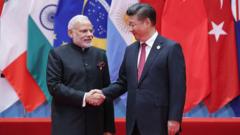Recent diplomatic activities suggest that India and China are making efforts to reset their ties, but historical mistrust and regional tensions pose significant challenges to their reconciliation.
India and China Seek a Cautious Reconciliation Amidst Ongoing Geopolitical Tensions

India and China Seek a Cautious Reconciliation Amidst Ongoing Geopolitical Tensions
As India and China cautiously approach a potential thaw in their relationship, border disputes and geopolitical rivalries can complicate the road to reconciliation.
In the sphere of global geopolitics, India and China find themselves at a crossroad, cautiously seeking to reset their historically strained relations. After enduring years of border skirmishes and rising tensions, recent diplomatic overtures indicate a potential thaw. The late visit of senior Indian officials to China and their participation in the Shanghai Cooperation Organisation (SCO) symbolize this shift, raising hopes for improved bilateral interactions.
Significant firsts include Defence Minister Rajnath Singh's five-year overdue visit to China, which has rekindled discussions surrounding their volatile 3,440km (2,100-mile) disputed border. Since the lethal Galwan Valley clash in 2020, where twenty Indian and four Chinese soldiers lost their lives, the friction in this zone has remained a pivotal issue. Nevertheless, pragmatism appears to be guiding both sides as they seek to establish ground rules that could stabilize their interactions.
In recent policy shifts, the two nations reached agreements concerning friction points in Ladakh, controlling their border dynamics at least temporarily. Furthermore, they have recommenced direct flights and allowed Indian pilgrims to visit sacred sites in Tibet, hints of mending their fractured ties. The economic dimension cannot be ignored either, with China representing India's second-largest trading partner, accounting for over $127 billion in bilateral trade last year. Such economic interdependence underscores the need for peace along their shared borders to foster growth in both nations.
However, an undercurrent of skepticism remains. Analysts assert that China is increasingly wary of India's perceived alignment with Western powers, particularly the U.S., which it sees as a strategic counterweight to its influence. Likewise, New Delhi is navigating its relationship with the West with trepidation, especially considering America's unpredictable stance during the Trump administration and its implications for regional security.
Military cooperation between China and Pakistan further complicates the landscape for India, which has observed recent clashes with its arch-rival. Additionally, historical grievances remain unaddressed, eroding trust; China’s territorial claims over Arunachal Pradesh, for example, continue to strain diplomatic relations.
China’s trade policies also pose challenges, as it has recently restricted crucial exports, potentially jeopardizing India’s manufacturing sector, leading the Indian government to engage in dialogue with Beijing. Despite these trade confrontations, China seeks to deepen its economic ties with India, albeit while maintaining its territorial ambitions.
For a meaningful reconciliation to occur, experts stress that both nations must compromise on principles of sovereignty, particularly in contentious areas like Arunachal Pradesh. However, it appears both nations are reluctant to concede ground, perpetuating a cyclical challenge that leaves their future relationship in a delicate balance.
As both India and China grapple with internal and external pressures, their willingness to cultivate a mutually beneficial relationship may ultimately dictate the trajectory of not only their bilateral ties but regional stability as well.





















